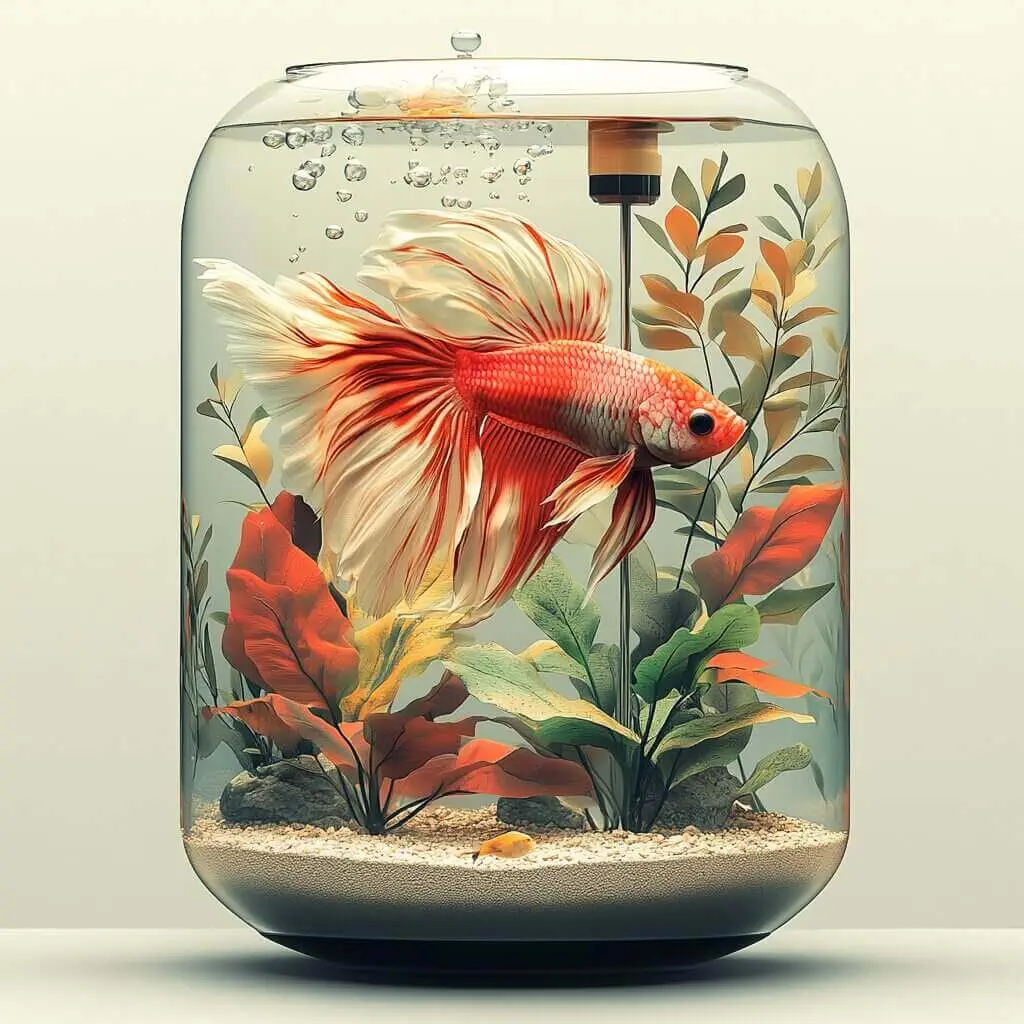Does your betta fish need an air pump? Many new fish owners ask this question. The answer is no. Betta fish have a special organ called the labyrinth. This organ lets them breathe air from the surface. They don’t need extra bubbles in their tank. 1
I’ve kept bettas for over 10 years. I’ve learned a lot about their needs. Bettas are unique fish with specific care requirements. So, does Betta Fish need air pump? In this guide, you’ll discover how to keep your betta happy without an air pump.
You’ll also learn when an air pump might be helpful. Ready to become a betta expert?
Key Takeaways
- Betta fish don’t need air pumps because they have a special labyrinth organ to breathe air from the surface.
- Live plants, regular water changes, and good filtration can keep oxygen levels high in betta tanks without an air pump.
- Signs of low oxygen in bettas include gasping at the surface, heavy breathing, and less activity.
- Air pumps may help in small tanks, hot weather, or if the betta shows stress signs.
- New air pump tech is gentle, making it more betta-friendly if needed.
Understanding Betta Fish and Their Natural Habitat

Betta fish have a special organ that lets them breathe air. They live in small, warm pools in Southeast Asia.
The Labyrinth Organ: Betta Fish’s Unique Respiratory Feature
Betta fish have a special organ called the labyrinth. This organ sits above their gills and works like lungs. It lets them breathe air from the surface. Most fish can’t do this. The labyrinth organ helps bettas live in low-oxygen waters. 1
Bettas are one of the few fish can breathe air directly, thanks to their labyrinth organ.
This unique feature sets bettas apart from 95% of other fish. They can take in oxygen from both water and air. This ability helps them thrive in small spaces and shallow waters. As an aquarist, I’ve seen bettas use this skill to survive in less-than-ideal conditions. 2
Natural Living Conditions of Bettas in the Wild
Moving from the unique labyrinth organ, let’s explore where bettas live in nature. These fish thrive in the shallow waters of Thailand. 3 Rice paddies and muddy puddles are their typical homes.
In these spots, oxygen levels can be low. But bettas adapt well. They share space with other aquatic species. This mix of life creates a rich, diverse habitat that betta fish require for their well-being. You’ll find bettas swimming in warm, still waters. 2 They often hide among plants and roots for safety.
The Importance of Mimicking Natural Environments in Betta Tanks
Bettas thrive in natural settings. Your tank should mirror their wild habitat. A 10-liter tank gives male bettas room to swim freely. 4 Add gravel, rocks, and live plants to boost their activity. These elements create a rich, engaging space for your betta.
To make your betta fish happy, try to copy nature. Live plants help clean the water and give your fish air to breathe. 2 Rocks and gravel make fun of places to hide and play. This will help your fish feel happy and act like an actual fish.
Your betta will show more vibrant colors and active swimming in a well-designed tank.
The Role of Air Pumps and Bubblers in Oxygenating Betta Tanks

Air pumps and bubblers boost oxygen in betta tanks. They create water movement, helping gas exchange at the surface.
How Air Pumps Contribute to Dissolved Oxygen Levels
Air pumps play a key role in boosting oxygen levels in fish tanks. They create bubbles that rise to the surface, stirring the water. This movement helps oxygen from the air mix into the water. Fish need this dissolved oxygen to breathe and stay healthy.
A well-oxygenated tank is the foundation of a thriving aquatic ecosystem. 5
An air pump with an air stone can help your fish get more air. It can increase dissolved oxygen by up to 2 mg/L. This is important for your fish, plants, and the good bacteria in your tank. It’s especially helpful in warm water, which doesn’t have as much air naturally.
For betta fish, a gentle air flow can mimic their natural habitat and keep them active. 6
Alternatives to Air Pumps for Betta Fish Tanks
Betta fish don’t always need air pumps. Here are some great options to keep your betta’s tank well-oxygenated:
- Live plants: Add plants like Java Fern or Anubias to your tank. They will help clean the water and give your fish air to breathe.
- Surface agitation: Use a filter that makes small waves on the water. This will help the air mix into the water and make it better for your fish to live in.
- Regular water changes: Replace 10-20% of the tank water weekly. Fresh water brings in more oxygen, which betta fish require for optimal health.
- Larger tank size: A bigger tank holds more oxygen. Aim for at least 5 gallons for your betta.
- Low-flow filter: Pick a filter that moves water slowly. It adds oxygen without stressing your betta.
- Proper tank placement: Put the tank in a spot with good air flow. This helps natural gas exchange at the water surface.6
- Floating plants: Add duckweed or water lettuce. They create shade and boost oxygen levels.
- Manual aeration: Use a turkey baster to gently stir the water. This will help the air mix into the water and make it better for your fish to live in.7
These methods work well in my 3.5-gallon betta tank with low-flow filtration. Next, let’s look at how to spot signs of low oxygen in your betta’s tank.
When to Consider Using an Air Pump in Your Aquarium
Air pumps can be helpful if your tank doesn’t have a good filter or if the water isn’t moving much. If your fish is gasping for air at the top of the tank, it might mean there isn’t enough air in the water. An air pump can help fix this. 8
Air pumps can be helpful in small tanks or tanks with many fish. They can also help keep the water good in hot weather, when it’s harder for air to mix into the water. 8 If your fish is acting sick or tired, an air pump might help them feel better. 7
Assessing the Need for Air Pumps in Betta Fish Care

Betta fish behavior can tell you if they need more air. Watch for signs like gasping at the surface or staying near the top of the tank. These clues can help you decide if you need an air pump.
Keep reading to learn more about keeping your betta happy and healthy!
Betta Fish Behavior and Indicators of Low Oxygen Levels
Betta fish show clear signs when oxygen levels drop. They may swim to the surface more often to gulp air. 2 You’ll see them breathing heavily, with their gills moving fast. Some bettas might become less active or hide at the bottom of the tank.
In extreme cases, they could lay on their side or float upright. These behaviors signal stress and a need for more oxygen in the water. 7 Monitoring your betta’s actions helps you spot problems early.
Let’s explore how tank size affects oxygen levels for your betta.
The Interplay Between Aquarium Size and Oxygenation
Tank size plays a big role in keeping your betta happy. Bigger tanks hold more water and oxygen. A 0.8 Liter to 1.4 Liter tank works well for adult bettas. 2 More space means less stress for your fish.
It also helps keep oxygen levels high.
Larger tanks make it easier to keep the water clean. This matters for oxygen, too. Clean water holds more oxygen, allowing fish to survive better. Your betta will breathe easier in a bigger, cleaner tank. 7 Next, let’s look at how filtration systems affect oxygen in betta tanks.
Filtration Systems and Their Impact on Betta Tank Oxygenation
Filters play a key role in keeping betta tanks healthy. They clean the water and add oxygen. A good filter moves water around, which helps mix in air from the surface. This process boosts oxygen levels in the tank.
Mechanical filters catch dirt and waste. Biological filters break down bad stuff in the water. Both help keep the water clean, which is important for your fish to be healthy. 2
Carbon filters help clean the water. They make the water smell better and look clearer. This helps the plants grow better, and the plants make more air for your fish to breathe.
Your filter choice can affect your betta’s comfort and health. 9 Now, let’s explore some practical tips for aerating your betta tank without an air pump.
Practical Tips for Betta Tank Aeration Without an Air Pump

Want to keep your betta happy without an air pump? You can use smart tank design and live plants to boost oxygen. These tips will help your betta thrive in a natural, pump-free home.
Strategic Aquarium Design to Enhance Natural Air Exchange
Design your betta tank for better air exchange, as betta fish need a bubbler for optimal oxygen levels. Use a large tank instead of a bowl. This gives more surface area for oxygen to enter the water. 10 Place live plants near the top of the tank.
Sponge filters help clean the water and give your fish air to breathe. They are gentle on your fish and will help move the water around. Keep the water level a little lower than the top of the tank..
This increases surface area and lets your betta gulp air easily. Next, let’s look at how live plants boost oxygen in betta tanks. 6
The Role of Live Plants in Oxygenating Betta Fish Tanks
Moving from tank design to plant life, let’s explore how greenery boosts oxygen for your betta. Live plants play a key role in keeping your fish healthy. They make oxygen through photosynthesis.
This process adds 5 to 7 milligrams of oxygen per liter to the water. That’s the ideal range for bettas. Plants also help clean the water by using up waste products. Some great options for betta tanks include Java Fern, Anubias, and Amazon Sword. These plants are easy to care for and thrive in low-light conditions. They’ll make your tank look nice while helping your betta breathe easy. 7
Water Maintenance Routines to Sustain Oxygen Levels
Live plants help keep your betta’s water clean. Now, let’s talk about water care. Regular water changes are key. Replace 10-15% of the tank water weekly. This removes waste and adds fresh oxygen.
Clean your filter media monthly. Rinse it in old tank water to keep good bacteria. Test your water often. Keep ammonia and nitrites at 0 ppm. Nitrates should stay below 20 ppm. These steps keep your betta’s home healthy and full of oxygen. 6
Advanced Considerations for Using Air Pumps in Betta Aquariums

Air pumps can be a great tool for betta tanks. You’ll find many options to fit your needs and your fish’s comfort.
Selecting the Right Air Pump for Your Betta Fish Tank
Pick a quiet, low-flow air pump for your betta tank. Look for models with adjustable flow rates to suit your fish’s needs. Small, compact pumps work well for betta tanks under 10 gallons.
Larger tanks may need stronger pumps to move more water. Check the pump’s noise level before buying – your betta will appreciate a peaceful environment. 6
Look for a pump that turns off by itself and has a backup battery. 7 This will help your fish get air even if the power goes out. Choose a pump that is strong and will last a long time.
Ceramic air stones make smaller bubbles that are better for your fish. Choose a pump that is the right size for your tank so it doesn’t scare your fish.
The Pros and Cons of Continuous vs. Intermittent Air Pump Usage
Once you choose an air pump, you might wonder how to use it. Using it all the time or only sometimes can be good or bad for your betta fish tank.
| Usage Type | Pros | Cons |
|---|---|---|
| Continuous | – Constant oxygen levels – Steady water circulation – Helps maintain stable temperature | – May stress Bettas – Higher electricity costs – Faster equipment wear |
| Intermittent | – Mimics natural conditions – Lower energy use – Less disruptive to Bettas | – Fluctuating oxygen levels – Requires timer setup – Possible equipment issues from frequent on/off cycles |
Using an air pump all the time can keep the air level in the water steady, but it might bother your betta. 6 Using it only sometimes can save energy and make the tank more like nature, but it can also cause the air level to go up and down. Which way is best depends on your betta and your tank. Watch your fish to see what it likes.
Innovative Air Pump Technologies and Betta Fish Compatibility
New air pump tech is changing betta care. Quiet, low-flow pumps create gentle currents without stressing fish. Some models have adjustable settings to match your betta’s needs. Smart pumps can even monitor water quality and adjust flow as needed.
These pumps work well with bettas. They add oxygen without making strong currents. This keeps bettas happy and healthy. The gentle flow mimics their natural habitat. It’s a great way to improve your betta’s tank without causing harm. 7
Conclusion
Betta fish don’t need air pumps. Their labyrinth organ lets them breathe air from the surface. Good filtration and regular water changes keep tanks healthy. Live plants boost oxygen levels naturally.
You can create a perfect home for your betta without extra gear. Focus on clean water, proper feeding, and a stress-free environment for a happy, thriving fish.
FAQs
1. Do betta fish need air pumps?
No, betta fish don’t need air pumps. They’re labyrinth fish, able to breathe air from the surface. But pumps can help keep water clean and add oxygen. Furthermore, betta fish are known to be territorial creatures, so it’s essential to provide them with enough space to establish their territory. When breeding betta fish, it’s important to introduce the male and female slowly and carefully to prevent any aggressive behavior. Additionally, providing a diet high in protein and regularly changing the water can also aid in successful betta fish breeding. For more betta fish breeding tips, it’s best to consult with experienced breeders or research reputable sources for guidance.
2. How do bettas get oxygen without a bubbler?
Bettas take oxygen from the water and air. They swim up to breathe atmospheric air. This unique trait lets them live in small tanks without air pumps.
3. When might a betta fish need more oxygen?
If you see your betta gasping at the surface often, it may need more oxygen. Warm water, lots of fish, or a dirty tank can lower oxygen levels.
4. Can air pumps stress betta fish?
Yes, powerful water flow from air pumps can stress bettas. They like calm waters. If using a pump, keep the flow gentle.
5. How else can I oxygenate my betta’s tank?
Regular water changes, live plants, and a good filter can boost oxygen, which betta fish may need. Also, leave some space at the top of the tank for air exchange.
6. Are there benefits to using an air pump for bettas?
While not needed, air pumps can help. They mix water, add oxygen, and support helpful bacteria. Just ensure the current isn’t too strong for your betta.
References
- ^ https://edis.ifas.ufl.edu/publication/FA212
- ^ https://www.ncbi.nlm.nih.gov/pmc/articles/PMC9334006/
- ^ https://animaldiversity.org/accounts/Betta_splendens/
- ^ https://www.ncbi.nlm.nih.gov/pmc/articles/PMC10936361/
- ^ https://atlas-scientific.com/blog/how-to-increase-oxygen-in-a-fish-tank/ (2022-02-25)
- ^ https://www.bettaboxx.com/betta-care/aeration-air-stones-pumps
- ^ https://www.freshwatersystems.com/blogs/blog/what-is-an-aquarium-air-pump-and-is-it-necessary?
- ^ https://www.swelluk.com/help-guides/why-are-my-fish-swimming-at-the-top-of-the-tank/
- ^ https://bettafish.org/care/
- ^ https://vetmed.illinois.edu/pet-health-columns/betta-fish/
- ^ https://aquariumwonder.com/fish/bettas/do-betta-fish-need-air-pump/ (2024-04-18)





